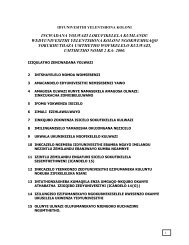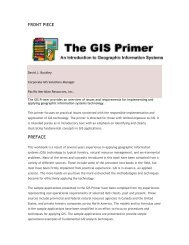Ecosystem Guidelines for Environmental Assessment
Ecosystem Guidelines for Environmental Assessment
Ecosystem Guidelines for Environmental Assessment
Create successful ePaper yourself
Turn your PDF publications into a flip-book with our unique Google optimized e-Paper software.
JAN VLOK<br />
SCEPS<br />
Quartz patches can support a wide array of succulents, such as<br />
Gibbaeum pubescens, Astroloba sp. and Glottiphyllum depressum.<br />
biodiversity specialists. Limiting an environmental investigation to one or the other means that the full<br />
range of potential impacts on biodiversity has not been considered. The findings of such an assessment<br />
would be incomplete, which can have negative ramifications <strong>for</strong> project planning and authorisation.<br />
What complicates matters, though, is that ecological processes are seldom easy to see - take, <strong>for</strong><br />
example, pollination, seasonal migration or seed dispersal - and can occur with great temporal and<br />
spatial variation.<br />
Nevertheless, some ecological processes can be effectively represented by spatial surrogates -<br />
mappable environmental features that serve as area-specific substitutes <strong>for</strong> the actual processes that<br />
need to be maintained.<br />
Spatial components of ecological process include physical linkages, boundaries and gradients in the<br />
landscape, such as:<br />
- River corridors,<br />
- The interface between different soil types, or between flat areas and slopes, or<br />
- Altitudinal changes in temperature and precipitation.<br />
Spatial components of ecological processes can thus be defined as mappable environmental features<br />
that are required to maintain specific ecological processes.<br />
80 : SPATIAL COMPONENTS OF ECOLOGICAL PROCESSES
















